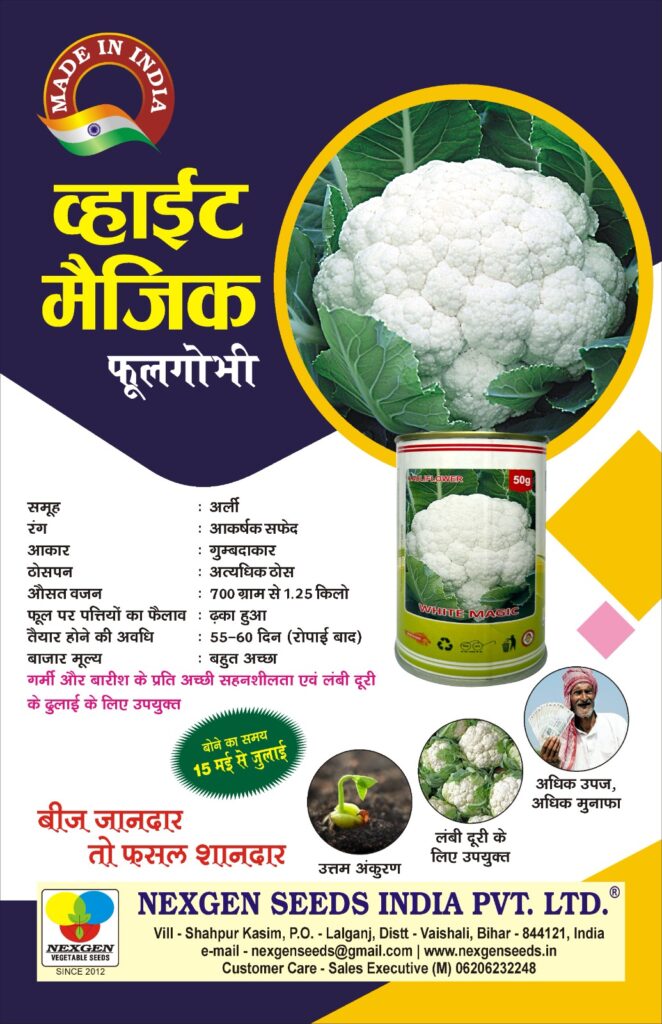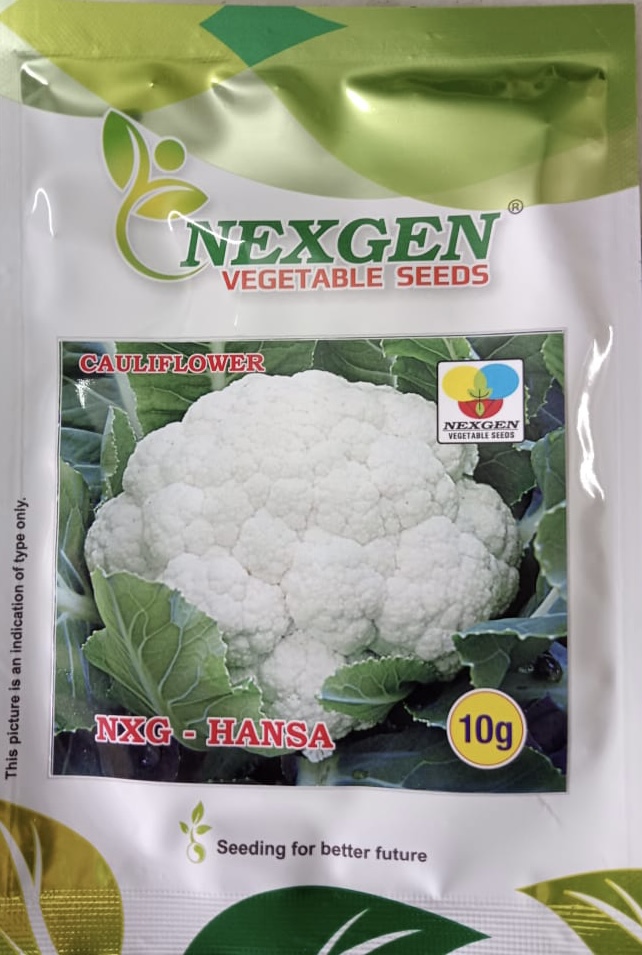
Introduction:
Undeniably, cauliflower occupies a special place in our kitchen gardens and dining tables, thanks to its versatility and nutritional benefits. This blog post is your comprehensive guide on everything there is to know about sowing, growing, and harvesting cauliflower, with a special focus on the varieties NXG Delight, NXG 172, NXG 911, NXG White Magic, NXG White Lady, NXG Tejas, NXG Karishma, NXG Anmol, NXG 1033, and NXG Hansa.
Understanding Cauliflower and Its Climate Requirements:
Cauliflower is a cool-season crop that thrives in a climate with temperatures ranging from 18 to 22 degrees Celsius. Extreme heat can cause premature bolting, which leads to small, undesirable heads.
Soil Requirement:
Cauliflower prefers well-drained, fertile soil with plenty of organic matter. The ideal pH level ranges from 6.0 to 7.0, which ensures the absorption of essential nutrients.
Cauliflower Sowing Guide:
Sowing Time:
The perfect time to sow cauliflower seeds depends on the variety and the local climate. Generally, late summer or early fall is ideal for sowing, ensuring the crop matures in cool weather.
Spacing:
Cauliflower plants need space to grow. A spacing of 18-24 inches between plants and 30-36 inches between rows generally yields the best results.
Sowing Method:
Start by sowing the seeds in a nursery bed or seed trays filled with a mix of compost and soil. Plant the seeds about half-inch deep and water regularly.
Understanding The Varieties of Cauliflower:
Whether you prefer your cauliflower white, green, or purple, there’s a variety to suit your palate. This section covers varieties from the NXG series, known for their vigor, adaptability, and high yields.
Seed Requirements:
On average, 1-2 grams of seeds are needed per square meter. For better germination, soak the seeds overnight in tepid water before sowing.
Creating the Perfect Nursery for Cauliflower Cultivation:
A well-prepared nursery ensures healthy seedlings. Keep the nursery bed moist and provide partial shade to the young plants. After 4-6 weeks, when the seedlings have 5-6 true leaves, they’re ready for transplanting.
Transplanting Cauliflower:
Before transplanting, water the nursery bed to minimize root damage. Place the seedlings in the prepared field, maintaining the recommended spacing.
Manure and Fertilizer Usage:
Add well-rotted farmyard manure during land preparation. A balanced fertilizer, with nitrogen, phosphorus, and potassium, is ideal for cauliflower. Additionally, side-dressing with nitrogen-rich fertilizer can boost head formation.
Harvesting Cauliflower:
Harvesting usually occurs 7-12 weeks after transplanting when the heads are compact, white, and firm. Cut the heads off the plant, leaving a few leaves to protect them.
Yield of Cauliflower:
The yield varies depending on the variety, growing conditions, and care taken. On average, you can expect about 25-30 tons per hectare.
In conclusion, growing cauliflower can be a rewarding experience, whether you’re a home gardener or a commercial grower. Understanding the needs of your chosen variety, proper sowing times, and the optimal use of manure and fertilizer can significantly improve your yield.

Recommended cauliflower Varieties of Nexgen Seeds:
Here are the recommended NXG series varieties of cauliflower:
- NXG Delight: Known for its early maturity and compact, uniform heads.
- NXG White Lady: Recognized for its stunning white curds and resistance to common diseases.
- NXG Tejas: A summer season variety with high heat tolerance.
- NXG Karishma: This variety is appreciated for its large, dense heads and vigorous growth.
- NXG Anmol: Adored for its excellent field holding capacity and uniform maturity.
- NXG 172: A variety that offers exceptionally large, white heads and is tolerant to black rot.
- NXG 911: This variety is known for its uniform, round, and compact white curds.
- NXG White Magic: As the name suggests, it produces magical, large white curds with good field holding capacity.
- NXG 1033: This variety is appreciated for its excellent curd quality and resistance to diseases.
- NXG Hansa: Known for its attractive, deep white curds and tolerance to temperature variations.
Post-Harvest Handling:
After harvesting, handle the cauliflower heads gently to prevent bruising. Store at a temperature of 0-2°C with high humidity to maintain freshness.
Pests, Diseases, and Their Management:
Cauliflowers can be susceptible to pests like aphids, cutworms, and cabbage root maggots. Diseases such as black rot, clubroot, and bacterial soft rot can also pose problems. Using disease-resistant varieties, crop rotation, and proper sanitation can help manage these issues.
Conclusion:
The joy of harvesting your homegrown cauliflower is incomparable. With the right knowledge and care, you can successfully cultivate this nutritious and versatile vegetable in your garden. Whether you’re a seasoned grower or a green-thumbed newbie, this complete guide to sowing, growing, and harvesting cauliflower is your go-to resource. Happy gardening!
Remember to share your cauliflower growing experiences in the comments section below. We’d love to hear from you!
Growing Cauliflower in Containers:
Not all of us have the luxury of a large garden, but don’t let that stop you from growing your own cauliflower! Many varieties can be successfully grown in containers. Choose a large pot, at least 12 inches deep and wide, with good drainage. Fill the pot with a mix of potting soil and compost, sow your seeds or transplant your seedlings, and ensure they get at least six hours of sunlight each day. Container-grown cauliflowers will need more frequent watering, and it’s a good idea to apply a liquid fertilizer every few weeks.
Cooking with Cauliflower:
Once you’ve harvested your cauliflower, the fun really begins. Cauliflower is incredibly versatile in the kitchen; it can be roasted, boiled, grilled, or even turned into a pizza crust! The different varieties offer slightly different flavors and textures, so don’t be afraid to experiment. Try the NXG White Lady for a classic cauliflower taste, or the NXG Tejas for something a bit different.
Cauliflower Nutrition:
Not only is cauliflower delicious, it’s also packed full of nutrients. It’s a great source of vitamins C, K, and B6, as well as fiber, protein, and potassium. Incorporating cauliflower into your diet can help improve digestion, reduce the risk of chronic diseases, and boost overall health.
Conclusion:
From sowing to harvesting, and from pot to plate, this complete guide to cauliflower has you covered. As you can see, growing your own cauliflower is not only rewarding, but also provides a bounty of nutritious, delicious meals. So why not give it a try? With these tips and techniques, you’ll be a cauliflower expert in no time.

Don’t forget to share this article with your fellow gardening enthusiasts, and be sure to leave any questions or tips of your own in the comments section below. Happy growing! Cauliflower Varieties: A Deeper Dive
Now that we’ve covered the basics of growing cauliflower, let’s take a closer look at the NXG series varieties we recommend. Each NXG series varieties has its unique characteristics and benefits:
- NXG Delight: This early maturing variety is a delight for gardeners who want to enjoy their harvest sooner. It boasts of compact, uniform heads, making it an excellent choice for those with limited space.
- NXG White Lady: This variety offers beautiful white curds and is resistant to many common diseases, making it a great choice for organic gardeners and those who prefer lower-maintenance plants.
- NXG Tejas: Love gardening during the summer season? NXG Tejas is a heat-tolerant variety that delivers despite high temperatures.
- NXG Karishma: This variety is a real gem in the garden with its large, dense heads. If you’re after high yields, NXG Karishma won’t disappoint.
- NXG Anmol: Known for its excellent field holding capacity, this variety allows for a flexible harvest time. It’s a great pick for busy gardeners who need a forgiving crop.
- NXG 172: With its large, white heads and tolerance to black rot, NXG 172 is a hardy choice that delivers both in quality and quantity.
- NXG 911: Gardeners love this variety for its uniform, round, compact white curds that are not only appealing but also delicious.
- NXG White Magic: True to its name, this variety offers large white curds that hold well in the field. An excellent choice for those who prefer a longer harvest period.
- NXG 1033: Known for its excellent curd quality and resistance to diseases, NXG 1033 is a robust and reliable variety for all types of gardeners.
- NXG Hansa: This variety stands out with its attractive, deep white curds and tolerance to temperature variations. It’s a versatile choice that thrives across different weather conditions.
Conclusion:
Growing cauliflower is a rewarding journey, from sowing the seeds to harvesting the fruits of your labor. With this comprehensive guide, you now have all the information you need to successfully cultivate and enjoy this nutritious and versatile crop in your garden.
Whether you’re just starting or you’re an experienced gardener, we hope you’ve found this guide helpful. If you have any questions or if there’s anything else you’d like to know about growing cauliflower, don’t hesitate to leave a comment below. Happy gardening, and enjoy your cauliflower adventure! Preserving Your Cauliflower Harvest:
Once you’ve harvested your cauliflower, it’s time to think about storage. Cauliflower can be blanched and frozen for up to a year, canned, or pickled. If you’re interested in preserving your cauliflower, check out our guides on freezing, canning, and pickling.
Cauliflower in Your Landscape:
Cauliflower isn’t just for vegetable gardens – it’s also a stunning addition to your landscape. The large, leafy plants can provide texture and contrast in your flower beds, and the colorful varieties can add an unexpected pop of color.
Common Cauliflower Problems and Solutions:
Like any plant, cauliflowers can sometimes run into problems. From pests like aphids and cabbage worms to diseases like clubroot and black rot, it’s important to keep an eye out for any signs of trouble. Regularly inspect your plants, keep your garden clean and well-maintained, and don’t be afraid to seek help if you’re not sure what’s affecting your cauliflowers.
Cauliflower in the Kitchen:
Cauliflower is a culinary superstar, capable of transforming into a variety of delicious dishes. From cauliflower rice to cauliflower mash, from roasted cauliflower to cauliflower pizza crust, this is one versatile vegetable. It’s also a great addition to stir-fries, salads, and soups.
Final Words:
Growing cauliflower can be a rewarding endeavor, yielding a bounty of fresh, nutritious produce right from your garden. With the right care, from sowing to harvesting, anyone can enjoy the benefits of this versatile crop.
We hope this comprehensive cauliflower guide has been helpful in your gardening journey. If you have any further questions or tips to share, be sure to leave them in the comments. Happy growing, and enjoy your harvest!
Remember, the joy of gardening is not just in the harvest, but also in the journey. So, whether you’re a seasoned gardener or just starting out, enjoy every moment of your cauliflower-growing adventure.
Top 20 problems faced by gardeners and farmers when growing cauliflower, along with their solutions:
- Climate Requirements: Cauliflower prefers cool weather and cannot tolerate extreme heat or frost. Solution: Choose the right season for cultivation. Plant cauliflower during the cooler months of spring or fall.
- Soil Requirement: Cauliflower thrives in well-drained, fertile soil with a pH level between 6.0 and 7.0. Solution: Prepare the soil by adding organic matter, such as compost or well-rotted manure, to improve the soil structure and fertility.
- Proper Sowing Time: Sowing cauliflower seeds at the wrong time can affect plant growth and yield. Solution: Sow cauliflower seeds indoors or in a nursery approximately 4-6 weeks before the last frost date in your area.
- Spacing: Insufficient spacing between cauliflower plants can lead to overcrowding and competition for nutrients. Solution: Maintain a spacing of 18-24 inches (45-60 cm) between plants to ensure adequate air circulation and room for growth.
- Sowing Method: Poor sowing techniques can result in uneven germination or weak seedlings. Solution: Sow cauliflower seeds in small containers or seed trays filled with seed-starting mix. Plant the seeds at a depth of ¼ to ½ inch (6-12 mm).
- Varieties: Different cauliflower varieties have varying growth habits, colors, and flavors. Solution: Choose the variety that suits your climate, market demand, and personal preferences. Popular varieties include NXG Delight, NXG White Lady, NXG Tejas, NXG Karishma, NXG Anmol, NXG 172, NXG 911, NXG White Magic, NXG 1033, and NXG Hansa.
- Seed Requirements: Insufficient or poor-quality seeds can lead to low germination rates and weak plants. Solution: Purchase high-quality cauliflower seeds from reliable sources. Check the germination rate and seed viability before sowing.
- Nursery for Cauliflower Cultivation: Inadequate nursery management can result in weak seedlings or disease spread. Solution: Set up a separate nursery area with proper ventilation, adequate sunlight, and controlled watering. Use sterilized soil or seed-starting mix for sowing seeds.
- Transplanting: Improper handling during transplanting can damage the delicate cauliflower seedlings. Solution: Transplant the seedlings carefully, ensuring that the root system remains intact. Water the transplants immediately after transplanting to reduce stress.
- Manure and Fertilizer: Incorrect use of manure and fertilizers can lead to nutrient imbalances or burning of plants. Solution: Conduct a soil test to determine the nutrient requirements of your soil. Based on the results, apply organic manure, such as compost or well-rotted cow dung, before planting. During the growing season, use a balanced fertilizer according to the recommended dosage.
- Harvesting: Harvesting cauliflower at the wrong stage can affect its taste and quality. Solution: Monitor the development of the curds (the edible part of cauliflower) regularly. Harvest when the curds reach the desired size, are firm, and have a compact appearance. Avoid waiting too long, as overmature cauliflower can become bitter or develop an open, loose structure.
- Yield: Low yield can be a result of poor plant health, pest and disease infestations, or inadequate care. Solution: Implement good agricultural practices, including proper watering, timely fertilization, weed control, and pest management. Monitor the plants regularly and address any issues promptly to maximize yield.
- Pest Control: Cauliflower is susceptible to various pests, such as aphids, caterpillars, and flea beetles, which can damage the plants and reduce yield. Solution: Employ integrated pest management strategies, including cultural practices (crop rotation, removing plant debris), biological controls (beneficial insects), and targeted pesticide applications if necessary.
- Disease Management: Cauliflower can be affected by diseases like clubroot, black rot, and powdery mildew. Solution: Practice crop rotation, ensure proper sanitation, and select disease-resistant varieties. Provide adequate air circulation and avoid overhead watering to reduce the risk of disease development. If needed, apply appropriate fungicides as recommended.
- Weeding: Weed competition can hamper cauliflower growth and reduce yield. Solution: Regularly remove weeds from the planting area through hand weeding or shallow cultivation. Mulching can also help to suppress weed growth.
- Irrigation: Improper watering practices, such as overwatering or underwatering, can lead to stunted growth or nutrient deficiencies in cauliflower plants. Solution: Maintain consistent soil moisture by watering evenly and deeply. Avoid waterlogging or allowing the soil to dry out completely. Mulching can help retain moisture in the soil.
- Nutrient Deficiencies: Inadequate nutrient supply can result in poor cauliflower growth and yield. Solution: Conduct regular soil tests to identify nutrient deficiencies. Based on the results, adjust fertilization practices to provide the necessary nutrients. Foliar feeding with micronutrients may also be beneficial.
- Sunlight Exposure: Insufficient sunlight can lead to weak or leggy cauliflower plants and reduced curd development. Solution: Choose a planting location that receives at least 6-8 hours of direct sunlight per day. If growing during the hot summer months, consider providing some shade to protect the plants from scorching.
- Temperature Extremes: Extreme temperature fluctuations can cause stress to cauliflower plants and affect growth and curd development. Solution: Protect young plants from frost by using row covers or planting in a greenhouse. In hot weather, provide shade or use techniques like misting or overhead sprinklers to cool the plants.
- Post-Harvest Handling: Improper handling and storage after harvesting can lead to spoilage and reduced shelf life of cauliflower. Solution: Harvest cauliflower in the early morning when the curds are cool. Remove any damaged or diseased portions and store the heads in a cool, dry place or refrigerate them to maintain freshness.

By addressing these common problems and implementing the suggested solutions, gardeners and farmers can improve their cauliflower cultivation practices and achieve better yields and quality.
- Market Demand: Lack of market demand or limited knowledge of market preferences can result in difficulty selling cauliflower produce. Solution: Conduct market research to understand the demand for cauliflower in your region. Identify potential buyers such as restaurants, grocery stores, or local markets. Build relationships with them to ensure a market for your harvest.
- Crop Rotation: Continuous cultivation of cauliflower or related crops in the same area can lead to soilborne diseases and nutrient depletion. Solution: Practice crop rotation by planting cauliflower in different areas of your farm each year. Rotate with unrelated crops to break disease cycles and maintain soil fertility.
- Timing for Succession Planting: Planting all cauliflower seeds at once can result in a surplus harvest that cannot be consumed or sold at once. Solution: Practice succession planting by sowing smaller batches of cauliflower seeds at regular intervals. This ensures a continuous supply of fresh cauliflower over an extended period.
- Pest and Disease Monitoring: Neglecting regular monitoring for pests and diseases can allow infestations to go unnoticed, leading to severe damage. Solution: Routinely inspect cauliflower plants for signs of pests or diseases. Early detection allows for timely intervention, such as pesticide application or implementing natural pest control methods.
- Quality Control: Inconsistent quality in cauliflower produce can affect marketability and consumer satisfaction. Solution: Implement strict quality control measures, including selecting healthy seeds, ensuring proper planting techniques, and maintaining optimal growing conditions. Regularly inspect the cauliflower heads for size, shape, color, and overall appearance.
- Post-Harvest Storage: Improper storage conditions can lead to spoilage and reduced shelf life of cauliflower. Solution: Store harvested cauliflower heads in a cool and humid environment, ideally at temperatures around 32°F to 40°F (0°C to 4°C) and relative humidity of 90-95%. Packaging the heads in perforated plastic bags can help maintain freshness.
- Value-Added Products: Limited market opportunities for fresh cauliflower alone can be a challenge. Solution: Explore value-added product options such as cauliflower rice, cauliflower pizza crusts, or pickled cauliflower. This diversifies your product range and opens up new market possibilities.
- Continuous Learning: Lack of knowledge and skills in cauliflower cultivation can hinder success. Solution: Stay updated with the latest research, attend workshops or training programs, and connect with local agricultural extension services. Continuous learning enables you to adopt new techniques and practices for improved cauliflower production.
Remember, successful cauliflower cultivation requires dedication, attention to detail, and continuous improvement. By addressing these challenges and implementing appropriate solutions, gardeners and farmers can enhance their cauliflower growing practices and achieve better results.
Top 20 frequently asked questions and answers on “Complete Cauliflower Guide: Sowing, Growing & Harvesting.
- Q: What are the climate requirements for cauliflower cultivation?
A: Cauliflower thrives in cool climates with temperatures ranging from 60°F to 70°F (15°C to 21°C). It prefers moderate sunlight and is intolerant to extreme heat.
- Q: What type of soil does cauliflower require?
A: Cauliflower prefers well-drained, fertile soil with a pH level between 6.0 and 7.0. The soil should be rich in organic matter and have good moisture maintenance capacity.
- Q: When is the proper time to sow cauliflower seeds?
A: Cauliflower seeds are usually sown indoors 6-8 weeks before the last frost date in your area. They can be transplanted outdoors when the soil temperature reaches around 50°F (10°C).
- Q: What should be the spacing between cauliflower plants?
A: The spacing between cauliflower plants should be approximately 18 to 24 inches (45 to 60 cm) to allow enough room for the plants to grow and develop their heads.
- Q: What is the recommended sowing method for cauliflower?
A: Cauliflower can be sown directly into the garden or started indoors in seed trays or pots. Starting seeds at home allows for better control over the growing circumstances.
- Q: What are some popular varieties of cauliflower?
A: Some popular cauliflower varieties include NXG Delight, NXG White Lady, NXG Tejas, NXG Karishma, NXG Anmol, NXG 172, NXG 911, NXG White Magic, NXG 1033, and NXG Hansa.
- Q: How many seeds are required for cauliflower cultivation?
A: On average, you will need about 100 to 150 seeds per 1,000 square feet (93 square meters) of growing area for cauliflower.
- Q: How can I create a nursery for cauliflower cultivation?
A: To create a nursery, sow the cauliflower seeds in seed trays or small pots filled with seed-starting mix. Keep the soil moist and provide adequate light until the seedlings are ready for transplanting.
- Q: What is the transplanting process for cauliflower seedlings?
A: When the seedlings have grown to about 4-6 weeks old and have developed a few true leaves, they can be transplanted into the garden. Dig holes with the appropriate spacing and gently place the seedlings, taking care not to damage the roots.
- Q: What qualities and quantities of manure and fertilizer should I use for cauliflower?
A: Cauliflower requires a balanced supply of nutrients. Incorporate well-rotted organic manure or compost into the soil before planting. During the growing season, use a nitrogen-rich fertilizer, such as a balanced 10-10-10 or 14-14-14 formula, following the manufacturer’s instructions.
- Q: When is cauliflower ready for harvest?
A: Cauliflower is typically ready for harvest 60 to 85 days after transplanting, depending on the variety. Harvest when the heads are firm, compact, and reach their full size, but before they start to separate or turn yellow.
- Q: How much yield can I expect from cauliflower plants?
A: The yield of cauliflower can vary depending on various factors such as variety, growing conditions, and care. On average, you can expect to harvest around 1 to 2 pounds (0.5 to 1 kg) of cauliflower per plant.
- Q: What are the recommended varieties of cauliflower for cultivation?
A: Some recommended cauliflower varieties for cultivation include NXG Delight, NXG 172, NXG 911, NXG White Magic, NXG 1033, NXG White Lady, NXG Tejas, NXG Karishma, NXG Anmol and NXG Hansa. These varieties are known for their good yields and quality heads.
- Q: How do I know when it’s the right time to harvest cauliflower?
A: Cauliflower heads are ready for harvest when they reach a mature size and have a firm, compact texture. The heads should be white or the color specified by the variety. Check the maturity dates provided for the specific variety you are growing.
- Q: Can I save cauliflower seeds for future planting?
A: Yes, you can save cauliflower seeds for future planting. However, cauliflower is a biennial plant, meaning it takes two growing seasons to complete its life cycle and produce seeds. Saving seeds requires allowing a plant to go to seed during the second year and collecting the mature seeds.
- Q: How should I store harvested cauliflower?
A: After harvesting cauliflower, remove the leaves and store the heads in a cool and humid environment. Place them in a perforated plastic bag or wrap them in a damp cloth or paper towel and keep them in the refrigerator. Cauliflower can stay fresh for up to one week when stored properly.
- Q: Are there any common pests and diseases that affect cauliflower?
A: Yes, cauliflower is susceptible to various pests and diseases. Some of the Common pests include aphids, cabbage worms, and flea beetles found during cauliflower cultivation. Diseases such as clubroot, black rot, and downy mildew can also affect cauliflower. Proper crop rotation, regular inspection, and appropriate pest control measures can help manage these issues.
- Q: Can I grow cauliflower in containers or pots?
A: Yes, cauliflower can be grown in containers or pots as long as they are large enough to accommodate the plant’s root system and provide adequate space for growth. Choose compact or dwarf varieties suitable for container gardening.
- Q: How often should I water cauliflower plants?
A: Cauliflower plants require consistent moisture, especially during the head development stage. Water deeply and regularly to cauliflower plants, aiming to keep the soil evenly moist. Avoid overwatering or letting the plants sit in soggy soil to prevent root rot.
- Q: Can cauliflower be grown year-round?
A: Cauliflower is a cool-season crop and performs best in mild climates. It can be grown year-round in regions with cool summers and mild winters. In areas with hot summers or freezing winters, it is typically grown as a spring or fall crop when temperatures are more favorable.
- Q: How can I prevent cauliflower heads from turning yellow?
A: Yellowing of cauliflower heads can be caused by excessive sunlight exposure or high temperatures. To prevent this, you can use techniques like blanching. About one to two weeks before harvesting, tie the outer leaves gently over the developing head to shield it from direct sunlight. This helps maintain the white color of the head.
- Q: Can I grow cauliflower from saved seeds?
A: Yes, you can grow cauliflower from saved seeds. However, it’s important to note that cauliflower is a cross-pollinating vegetable, and saved seeds may not produce plants that resemble the parent plant. If you want to maintain the characteristics of a specific variety, it’s best to purchase fresh seeds each season.
- Q: How long does it take for cauliflower seeds to germinate?
A: Cauliflower seeds usually germinate within 7 to 14 days under optimal conditions. However, germination period can vary depending on reasons such as moisture levels and temperature. Providing consistent moisture and maintaining a temperature of around 70°F (21°C) can promote quicker and more uniform germination.
- Q: Can I grow cauliflower in a raised bed?
A: Yes, cauliflower can be grown in a raised bed. Raised beds provide good drainage and can be filled with high-quality soil, which is beneficial for cauliflower growth. Ensure the raised bed is wide and deep enough to accommodate the cauliflower plants and follow proper spacing guidelines.
- Q: How do I prevent common cauliflower diseases like clubroot?
A: To prevent clubroot and other soil-borne diseases, practice crop rotation. Avoid planting cauliflower or other brassica crops in the same spot for several years. Additionally, ensure the soil is well-drained and enriched with organic matter to promote healthy plant growth and reduce disease incidence.
- Q: Can I grow cauliflower in a greenhouse or protected environment?
A: Yes, cauliflower can be grown in a greenhouse or protected environment. Greenhouses provide controlled conditions, protecting the plants from extreme temperatures and pests. It allows for year-round cultivation and can help extend the growing season in regions with shorter summers.
- Q: How can I extend the harvest period for cauliflower?
A: To extend the harvest period, consider planting cauliflower varieties with different maturity dates. Choose early, mid-season, and late-season varieties. By staggering the planting and selecting varieties with varying maturation times, you can enjoy a continuous harvest over a longer period.
- Q: Can I grow cauliflower from transplants purchased at a nursery?
A: Yes, you can grow cauliflower from transplants purchased at a nursery. Transplants provide a head start and can save time compared to growing from seeds. Ensure the transplants are healthy, well-developed, and acclimated to outdoor conditions before transplanting them into your garden.
- Q: Can I interplant cauliflower with other vegetables?
A: Interplanting cauliflower with other vegetables is possible, but it’s important to consider the spacing requirements and growth habits of the companion plants. Avoid overcrowding to prevent competition for nutrients and space. Good companion plants for cauliflower include beets, carrots, and lettuce.
- Q: How can I protect cauliflower plants from pests like cabbage worms?
A: To protect cauliflower plants from cabbage worms and similar pests, you can use physical barriers such as floating row covers or fine mesh netting. Applying organic pest control methods can also be effective. Here are a uncommon methods that can protect cauliflower plants from pests you can try:
- Handpicking: Inspect your cauliflower plants regularly and manually remove any cabbage worms you find. This method is suitable for small gardens or if you only have a few plants.
- Bacillus thuringiensis (Bt): Bt is a natural bacterium that targets certain pests, including cabbage worms. Look for a Bt-based insecticide labeled for use on caterpillars and follow the instructions for application. Bt is safe to use and won’t harm beneficial insects.
- Neem oil: Neem oil is an organic insecticide that can repel and disrupt the lifecycle of pests. Dilute neem oil according to the instructions and spray it on your cauliflower plants, paying attention to the undersides of the leaves where cabbage worms often hide.
- Companion planting: Interplanting cauliflower with companion plants that repel pests can help deter cabbage worms. Examples of companion plants that may be effective include mint, thyme, rosemary, and marigolds.
- Crop rotation: Practice crop rotation by avoiding planting cauliflower or other brassicas in the same location year after year. This can help prevent the buildup of cabbage worms and other pests in the soil.
- Floating row covers: Covering your cauliflower plants with floating row covers or fine mesh netting can physically block cabbage worms from reaching them. Make sure the covers are securely anchored to prevent pests from finding their way underneath.
Remember to monitor your plants regularly and take action at the first signs of pest infestation. By combining these methods, you can protect your cauliflower plants and reduce the damage caused by cabbage worms.
Read More: Maximizing Yield with Cauliflower Seeds in India
